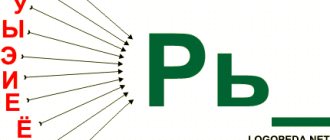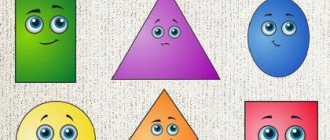As children grow up, many questions arise: “What is this?”, “What is this for?” etc. Adults should pay more attention to a child who is actively developing. In this article we will look at tips on how to easily and quickly teach kids the names of the months of the year.
Children are interested in various topics, including serious ones. When parents encounter something like this, they begin to wonder how to properly answer or explain. For example, they hear the question: “Mom (dad), what is November?” How can you explain to your child in an accessible way that there are 12 months in a year, of which 3 are winter, 3 spring, 3 summer and 3 autumn? That every month has a name, that January is a winter month, and July is a summer month? How to learn the names of all months with your child? And not just find out, but teach them to distinguish them based on specific characteristics?
Where to start learning?
It is necessary to begin the explanation with what a month is in general, how many there are in a year, and why it is customary to divide the year into seasons. Then you need to talk about the generally accepted procedure and begin training by studying the months, starting with the first - January.
Note! A quick way to remember the number of days in a month: clench your fist and look at the bones. The first is January. The month on the bone has 31 days, on the socket - 30.
Differences from other seasons
You can often hear children say that if snow has fallen, then winter has already come. But in fact, this symptom occurs both in late autumn and early spring. It is important to emphasize that snow alone does not indicate the onset of winter.
We can talk about a change of season when 5 signs coincide:
- dense, low-hanging clouds, gloomy sky;
- a blanket of snow and ice on the ground and trees;
- short daylight hours;
- hibernation of wildlife;
- appearance of “winter” birds.
Names of the months in children's pictures
All children love games. It will be more interesting and easier for your child to learn the names of the months if he is shown story-based illustrations or presentations. If parents independently make a presentation about the seasons for their child, it will be even better. An excellent option is to create it together with your child. This way he will remember the names faster.
By finding illustrations about each month and showing them to the child, the parent will be able to fix their names in his memory. To do this, you need to select pictures that demonstrate the life of animals in each season, the type of clothing for each season, etc.
To interest your son (daughter), the presentation must be colorful. You can also display the features of each month. For example, September - leaves fall, the school year begins, and children go to school. In presentations, you can focus on holidays. For example, December - New Year, decorating the Christmas tree and home. Be sure to include the child’s birthday in them - he will definitely know and remember this day.
Winter months
The child needs to be explained that there are 3 winter months - December (ends the year and begins winter), January (begins the year) and February (the harshest month, with blizzards and snowfalls). It is important to choose thematic pictures for the story.
Spring months
The first month of spring is March. This is the period when primroses - snowdrops - appear. The second month is called April. This is a period of changeable weather: sometimes the sun shines, sometimes it rains. The third month – May – is the time when nature begins to clothe the forest. Plot illustrations are also appropriate for the explanation.
Summer months
June is the first month of summer. In ancient times it was called “worm”. This month has the longest day and shortest night of the year - June 22. June is followed by July, the month when linden blossoms intensively. Summer ends - August - time for harvest. In addition to pictures, you can choose riddles that describe each month.
Autumn months
There are also 3 autumn months: September (early autumn), October (golden autumn) and November (late autumn). To describe the season, you can select signs for each month.
Game "4 seasons and 12 months"
Kindergarteners aged 3-4 years play, that is, the younger group.
Game objectives:
- teach the relationship between calendar times and a certain palette;
- develop mathematical skills - the ability to count to 4 and 12, divide geometric shapes into equal parts, name the months sequentially;
- develop memory, ability to concentrate and think logically.
For the lesson, you need to make a circle, divide it into 4 equal parts, paint each part with a color corresponding to the season: blue - winter, green - spring, yellow - summer, red - autumn. Children must guess which season each part of the circle belongs to and tell why this color was chosen.
For the middle age group, the task is made more complicated; each season of the circle is divided into 3 months.
How to learn the names of the months from books
Experts recommend buying children's educational and developmental books about the seasons and months. Such manuals explain to children the features of nature and the signs of the months in an accessible way. Some editions of such books contain tasks for consolidating material that will strengthen the memory of the topic studied.
Poems can help you learn the names of the months. After studying them, your memory will improve. You need to buy special literature with poems, fairy tales and stories about the 12 months. The book “365 Bedtime Stories” has proven itself to be excellent. The pictures in it are sorted by season, and each page corresponds to one calendar day. The book contains poems and stories that fully explore the theme of the 12 months. It's great for teaching with kids. No less useful is the encyclopedia “Seasons” with answers to many questions.
Didactic game "Seasons"
The middle group plays, preschoolers 4-5 years old.
The purpose of the didactic game “Seasons” is to form and consolidate knowledge about the sequential change of seasons, instilling a respectful attitude towards nature.
The activity helps preschoolers:
- remember the seasons of the year and the sequence of their alternation;
- correctly identify visual seasonal signs;
- consolidate ideas about the features of the 4 calendar times;
- develop observation, visual memory, ability to concentrate, speech skills;
- cultivate love in nature, a caring attitude towards its objects;
- see natural beauty in all seasons.
For the game, you need to prepare 4 illustrations depicting the same landscape in different seasons, cut out cards with depicted signs, objects and phenomena of each season.
Children look at pictures of seasonal landscapes. The teacher shows the cards one after another, and the students choose images that correspond to the selected illustrations of the seasons, name what is depicted, and explain the choice. The first participant to choose the correct cards without errors wins.
For older groups, the game can be complicated.
To make it more difficult, the teacher himself lays out the cards according to the pictures of landscapes, but incorrectly. The children's task is to move the cards to the appropriate seasons.
Learn the names of the months by playing
Theatrical scenes will help your child remember the names of the months and seasons. The child can be both a participant and a spectator. You can also pick up riddles or come up with them yourself. For example, draw people wearing clothes according to the seasons and ask the child to name what time of year they wear such clothes. Drawing pictures with your child that correspond to each season will also be useful.
A great way to learn and remember the months is a didactic game. They are developed specifically for preschool children. They also demonstrate relationships with the environment, develop memory and logic.
Information that is interesting to children is remembered quickly. They always want to learn a lot of new things, so they ask adults questions and explore the world. Children are good communicators who know how to listen. Studying the months is a fun topic for a child. He will be happy to study it with mom or dad.
"Seasons" for older preschoolers
For a preparatory group of preschoolers, you can play a game using computer technology. The teacher needs to prepare slides depicting pictures-answers to questions and riddles. From the presented pictures, children must choose the correct ones and click on them with a computer mouse.
The goal of the game is to form ideas about seasonal changes in nature and develop cognitive abilities through the use of computer technology.
Objectives of the didactic game “Seasons”:
- formation of ideas about the world around us, about the relationship between the changing seasons and objects of living nature and humans;
- consolidation of knowledge about the signs of spring, summer, autumn, winter;
- consolidation of knowledge about deciduous trees, hibernating animals, migratory birds;
- developing the ability to answer questions, solve riddles, speak competently and consistently;
- increase in cognitive activity;
- development of speech skills, increase in vocabulary;
- development of memory, hearing and vision perception, finger motor skills, ability to concentrate, and think logically.
The first group of slides concerns autumn. The teacher asks a riddle, the children guess what season is depicted. Next, the teacher asks questions: by what signs did the pupils identify autumn, what color are the leaves on the trees, what clothes are the people in the picture wearing, why are they dressed that way. The next slide shows autumn leaves, children must name which tree they came from.
The second group of slides concerns winter, children guess the riddle, tell how they identified winter, how people are dressed. On the second slide, from the animals presented, those that hibernate are selected. In the third of the presented pictures, choose the correct answers to riddles about a snowflake, a snowman, snowfall, frost, frost, icicles.
Next, preschoolers look at spring, guess the riddle, explain the choice of pictures, and tell how people are dressed. On the second slide, choose migratory birds from among the depicted birds. In the third of the presented images, choose answers to riddles about snowdrops, the sun, grass, streams, drops, rooks.
Next, the children look at summer, give an answer to the riddle, explain the choice of the picture, and explain why the people in it are lightly dressed. On the second slide, count the number of butterflies in forward and reverse order. At the third stage, edible mushrooms are selected from the presented mushrooms.
At the end of the game, the teacher asks the children to draw their favorite season.








